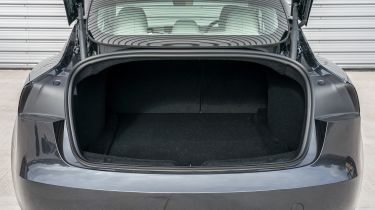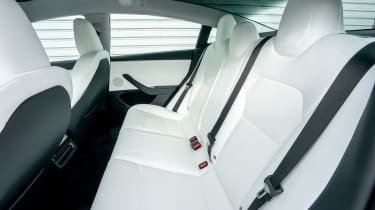Tesla Model 3 - Practicality, comfort and boot space
Two luggage areas make the Tesla Model 3 a reasonably practical proposition, although there are rivals with more passenger space

The Tesla Model 3 is intended to tempt buyers away from three-box saloons like the BMW 3 Series, Mercedes C-Class and Audi A4, so it makes sense that it also takes a similar approach to housing its occupants and luggage. It’s a four-door saloon with an ample boot, plus a separate storage area under the bonnet – one of the benefits of doing without a traditional internal combustion engine.
Visibility is also excellent due to a low scuttle that gives an unobstructed view forward, plus there are parking sensors front and rear (which measure in inches how far away you are from an object) and a high-resolution camera system makes the Model 3 easy to place when parking in a tight car park.
| Dimensions | |
|---|---|
| Length | 4,720mm |
| Width | 1,850mm (2,089mm inc mirrors) |
| Height | 1,441mm |
| Number of seats | 5 |
| Boot space | 594-977 litres |
Dimensions and size
The Tesla Model 3 measures 4,720mm long, 1,850mm wide and 1,441mm tall. In other words, it’s slightly shorter and wider than a 3 Series or the fully electric BMW i4. It’s also smaller than the Tesla Model S flagship saloon, and feels far better suited to British roads as a result.
How practical is the Tesla Model 3?
Seats & space in the front
The Model 3 is designed to carry four adults, and it manages that task well: there’s loads of space in the front, and its minimalist design helps add a sense of airiness. It’s easy to get comfortable in the driving seat thanks to 12-way electric adjustment, while the more heavily bolstered sports seats fitted to the Performance version provide excellent support in corners.
Used - available now

2023 Tesla
Model 3
78,210 milesAutomaticElectric
Cash £15,895
2021 Tesla
Model 3
12,270 milesAutomaticElectric
Cash £19,587
2021 Tesla
Model 3
51,584 milesAutomaticElectric
Cash £15,800
2023 Tesla
Model 3
68,697 milesAutomaticElectric
Cash £17,500There’s plenty of storage in the front, with the centre console featuring wireless charging pads for two phones and two enormous cubbies: one under the large armrest and the other a little further forward below a sliding cover. The door bins are also generously sized, with two cup holders for those in the front. Our biggest issue with the glovebox isn’t the size – though it is pretty slim – it’s the lack of a physical release, so you must use the touchscreen or voice commands to gain access.
Seats & space in the back
If you have to carry five people at once, the Model 3 can handle it. A completely flat floor in the rear provides space for everyone’s feet, plus there’s enough head and legroom to enjoy longer journeys. The rear seats are heated as standard, which is a nice touch because that’s often an option on rival cars.
The Model 3 isn’t perfect, though, as the low-mounted seats push passengers’ legs upwards, giving them only limited under-thigh support. The larger Volkswagen ID.7 is much better for carrying passengers in the back, with its extra width providing even more shoulder room for three adults sitting next to one another.
Two ISOFIX mounting points for child seats are provided on the outer positions of the rear bench. An ID.7 provides an additional point on the front passenger seat, making the arrangement of child seats a little more flexible.
Boot space
The Tesla Model 3 has an impressive 594-litre boot that’s larger than what you'll find in the Polestar 2 and has an extremely deep under-floor storage area. However, the Model 3’s narrow boot opening makes loading items trickier than with the BMW i4, Polestar 2, or ID.7, because these all feature more versatile hatchback tailgates.
The ‘frunk’ under the bonnet is accessible either using the car’s touchscreen or the Tesla smartphone app. Its 88-litre capacity is big enough for two small soft bags or general odds and ends, but you'll need to adhere to a weight limit of 50kg. You can also lower the Model 3’s split-folding rear seats if you need to haul longer items.
Towing
If you want to use a Model 3 to tow anything, you can order yours with a tow bar for an extra £1,300. Although the Model 3’s maximum towing capacity of 1,000kg, falls short of the BMW i4’s 1,600kg maximum capacity, and the 1,500kg the Polestar 2 can tow.









